|
Political Button Collecting and Reproductions
| by Michael J. McQuillen
Posted 11/2010
|
 |
One of the fastest growing hobbies in the United States today is the collecting of political campaign buttons and related paraphernalia. It is hard to attend an antique show or flea market without coming across at least a few of these little pieces of history for sale tucked away in a dealer's showcase or cigar box.
Our country has a long tradition of producing buttons, banners, pamphlets, bumper stickers and a myriad of other items to show support for the political candidates of one's choice. The earliest presidential items produced were metal clothing buttons worn on the coats of George Washington's supporters during his first inauguration in 1789. Less than a few hundred of these buttons survive to this day and usually will sell in excess of $1,000.
In the late 1800s, reproductions of these buttons were made for the 1876 Centennial and the 100th anniversary of the first Inaugural. Other Washington reproductions were made in the 1940s and for the Bicentennial. This brings us to one of the more important issues in the hobby:
How To Identify Reproductions and Fakes. Many antique and collectible fields are haunted by the occasional fake or deceptive piece. Unfortunately, the field of political buttons is no different. While it usually takes expert knowledge to separate Washington Inaugural clothing buttons from reproductions, it is much easier to detect reproductions of buttons from the past 100 or so years.
In the late 1960s, a prominent collector and dealer of political buttons decided to manufacture his own line of Nixon and McGovern buttons to sell and trade. About this time, Kleenex Tissues and Abbott Laboratories independently produced and distributed sets of reproduced and fake buttons depicting candidates from earlier campaigns. None of these buttons were put into circulation with the intent of defrauding or misleading anyone. Most were clearly marked with the year of manufacture.
By 1972, it was obvious to collectors that reproduced and fake buttons could cause a great problem. To help combat this, President Richard Nixon signed the Hobby Protection Act, which basically required that campaign buttons could not be produced after the year of the campaign unless they were clearly marked "Reproduction."
That same year, the American Oil Company produced what has proven to be the most troublesome of reproduction sets. Thirty-eight different pin-back buttons were produced to be given away to customers, one at a time, when they filled-up their cars with gasoline. An 8 x 10-size picture frame with a red or blue background was also available to display one's completed set. The buttons were each marked "A-O-1972-#" on the curl, or edge, of the button with the candidates’ last name and the year they ran.
By looking at the curl of a political button, you can quickly determine if it is part of this reproduction set. Frequently, you will see complete sets at antique shows and flea markets priced anywhere from ten dollars to hundreds of dollars. Beware! This set is attractive but has no value to political button collectors.
Occasionally, an unscrupulous individual will attempt to scratch the “Reproduction” wording off the button and repaint the affected area. If you find a button that is suspicious-looking or has an uneven surface and mismatching paint, don't buy it! At least 20 companies have produced bogus buttons for one reason or another. Fortunately, most are easily detected with a little practice.
It is important to define the difference between buttons that are reproductions and those that are fakes. A reproduction is a button that is made to look exactly like or very similar to a button that was manufactured during the campaign. A fake is a button that is not necessarily supposed to resemble an actual campaign button.
A warning sign to look out for in determining if a button is a genuine campaign item is painted backs. Frequently, someone will color the back of a button to hide where the word Reproduction might be marked. Another red flag is if the design on the button is hazy or unclear. This might indicate that a copy of an original button was turned into a reproduction.
Keep in mind that just because a button looks old doesn't mean a thing. There are several methods of aging a button’s appearance; some of which you really don't want to have described!
Pin-back buttons were first produced during the 1896 presidential campaign between William McKinley and William Jennings Bryan. At this time, many tobacco, gum and other companies had celluloid-covered buttons produced supporting both candidates. Celluloid is a plastic-type material that is wrapped around the outside of a paper-covered button to protect it. In the last few decades, celluloid has been replaced with acetate, which is a similar but more durable material.
Around 1920 with the campaigns of Warren G. Harding and James Cox, lithographed buttons became more commonplace. Lithographed buttons (lithos) were much simpler to produce as they didn't require a multi-phase manufacturing process. Instead, a lithographed picture or design was painted or sprayed directly onto a metal sheet which was then stamped into buttons.
By the 1950s, many campaigns were again more commonly using celluloid\acetate (cello) buttons, as they could be ordered in smaller quantities than what was required in litho buttons. It is important to know the difference between these types of buttons for one very good reason: if you have a litho button with a pre-1920 candidate on it, you probably have a reproduction. Also, if you have a button that pictures a candidate who ran before 1896, you probably have a fake.
In recent years, many institutions, including the Richard Nixon Presidential Library, have gotten into the “repro” button business. Around 15 years ago, I was dismayed to find a selection of unmarked fake buttons at a Yorba Linda, California, museum being offered for sale. While the asking price of a dollar each indicated that the museum staff was not trying to get rich; the problem of selling fakes does not help the hobby.
Following a few phone calls to the Federal Trade Commission (not to mention the story being picked-up by a national news service), sales of the fake buttons were discontinued. The Eisenhower Museum in Abilene, Kansas, at that time was also selling reproduction buttons, but all were marked with the required disclaimers.
Commemorative buttons have been produced over the years that picture Washington, Lincoln or some other early president on them as advertising or special event novelties. I am frequently asked, "Is my Lincoln button worth big bucks?" The answer to that is, while it is not valuable as a campaign button, it may be as an advertising button.
Specialists who collect specific candidates can be a valuable resource when it comes to identifying some of the more misleading fakes. I, for example, collect items from the 1940 campaign of Wendell Willkie. In my collection, I have a special frame containing more than 20 different fake and reproduction Willkie buttons—several of which would fool a majority of political collectors.
Recently, following the election of Barack Obama, a number of blue, black and white buttons from his early campaign for the Illinois State Senate began appearing on Internet auctions after an original button sold for in excess of $2,000 at an auction. Unfortunately, it is very difficult to tell the difference between an original and a fake made yesterday, with only slight differences in the typeface being a clue. As with any Internet auction, “Let the Buyer Beware!”
My suggestion to any collector is to buy what you find appealing and not worry so much about the long-term investment. If you are careful and try not to buy reproductions or fakes, most of your experiences will be positive.
___________________________________
Michael J. McQuillen is a collector and dealer of political memorabilia. He collects buttons and items of all kinds and would be happy to correspond with anyone about this interesting hobby. He can be reached by writing him at: P. O. Box 50022, Indianapolis, Indiana 46250-0022, or e-mail: Michael@politicalparade.com. Or visit his website: www.PoliticalParade.com
for more information.
|
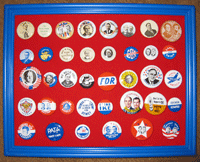
The 1972 American Oil Company set is the most commonly-found reproduction set
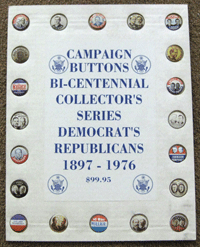
In 1976, one could purchase the Bi-Centennial Collector’s Series of reproduction buttons for only $99.95, retail value today, about $5.
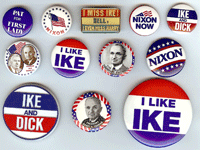
Presidential museums, surprisingly enough, are guilty of infiltrating the hobby with fake buttons and even bumper stickers. Some of these Eisenhower and Nixon buttons are marked “Reproduction;” some not, but all are worthless.
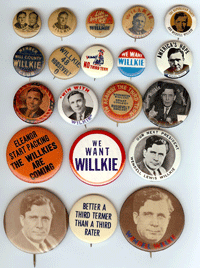
A selection of fake and reproduction Willkie buttons from the author’s collection.
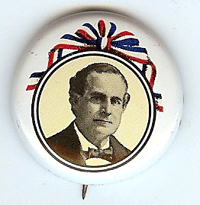
Worth around $150 when original, this 1972 reproduction of a William J. Bryan campaign button can confuse collectors since it is nearly 40 years old; retail value, about 50 cents.
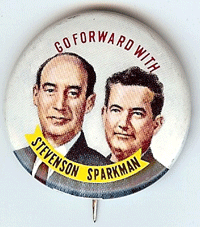
One of the more easily confused 1972 reproductions, this
Stevenson - Kefauver jugate button is very similar in
appearance to the original.
|